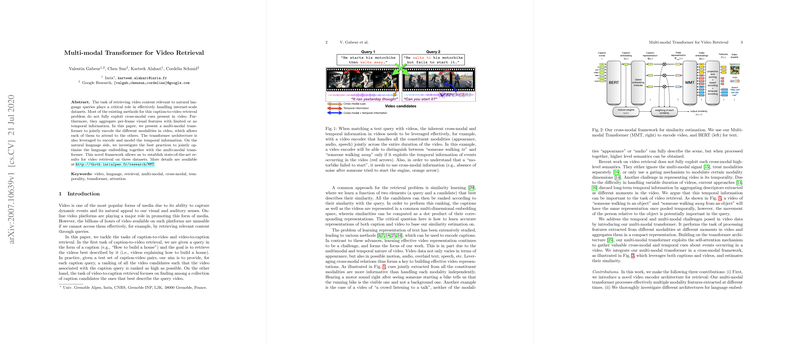Multi-modal Transformer for Video Retrieval: An Expert Overview
The paper "Multi-modal Transformer for Video Retrieval" addresses the complex task of video retrieval using a multi-modal transformer architecture to leverage the cross-modal and temporal information inherent in video content. It presents a framework that integrates the transformer architecture to effectively encode and model various modalities present in videos alongside temporal dynamics. This paper puts forward a comprehensive approach encapsulating video and language embeddings for enhanced video retrieval capabilities.
Key Contributions
- Video Representation via Multi-modal Transformer: The paper introduces a novel video encoder architecture based on a multi-modal transformer, capable of processing multiple modalities—such as appearance, motion, audio, and text—jointly. This architecture leverages self-attention mechanisms to facilitate cross-modal interactions and capture long-term dependencies, addressing the challenges posed by the temporal and multi-modal nature of video data.
- Enhanced Language Embedding Framework: The use of a well-optimized BERT model to encode natural language queries allows for more effective representation of captions. The paper explores various language embedding architectures, showing that fine-tuning BERT provides the most superior results for video retrieval tasks.
- State-of-the-Art Results: The paper reports state-of-the-art performance on standard video retrieval datasets, including MSRVTT, ActivityNet, and LSMDC, showcasing the efficacy of the proposed framework. The developed system exceeded previous benchmarks by capturing intricate video features through its sophisticated transformer-based design.
Methodological Insights
Video Embedding
The paper details the process of using pre-trained expert models to extract features from diverse modalities present in videos. Each modality is processed through a transformer-based architecture, aggregating the extracted features into a cohesive representation that explores the temporal relationships and contextual information between modalities. This approach facilitates the estimation of similarities with natural language captions by utilizing a shared embedding space.
Language Embedding
The LLM construction relies on a BERT-based architecture to derive embeddings from captions. The framework capitalizes on the contextualized nature of BERT embeddings, further refining these by incorporating gated mechanism embeddings to align them with the multi-modal video representations.
Implications and Future Directions
This paper implies significant practical advancements in the field of video retrieval, with potential applications spanning content recommendation, video search engines, and automated video summarization. From a theoretical perspective, the integration of transformer-based architectures for multi-modal data representation encourages further exploration into more nuanced machine learning tasks involving diverse data types.
Future research could delve into the scalability of these methods for real-time applications or extend the framework to other media forms beyond video and text. Additionally, exploring unsupervised or semi-supervised techniques for multi-modal learning could improve the adaptability of such systems to new datasets and domains without extensive labeled data.
Conclusion
The "Multi-modal Transformer for Video Retrieval" paper presents a sophisticated and technically sound approach to video retrieval, employing advanced transformer methodologies to harness the multifaceted nature of video content. By achieving high performance across several benchmarks, the work lays a foundation for enhanced retrieval systems in complex datasets. This contribution marks a significant step towards unlocking the potential of transformer architectures in multi-modal and temporal information processing.
